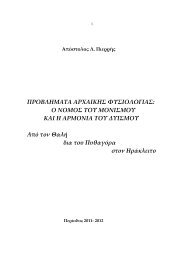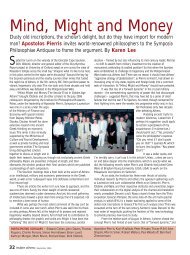chapter 10 the monism of darkness and the dualism of limit and ...
chapter 10 the monism of darkness and the dualism of limit and ...
chapter 10 the monism of darkness and the dualism of limit and ...
Create successful ePaper yourself
Turn your PDF publications into a flip-book with our unique Google optimized e-Paper software.
MONISM OF DARKNESS - DUALISM OF LIMIT AND INDETERMINACY 59<br />
(families, clans, phratries) or even <strong>of</strong> an entire city, in many places (cf.<br />
F. Jacobi FrGrH IIIb Supplement, A Commentary on <strong>the</strong> Ancient<br />
Historians <strong>of</strong> A<strong>the</strong>ns vol. I, p. 182). The A<strong>the</strong>nians in particular,<br />
sacrificed to <strong>the</strong> Tritopatores before getting married <strong>and</strong> prayed to<br />
<strong>the</strong>m for children (Phanodemus FGrH 325F6: º·Ófi‰ËÌÔ˜ ‰b âÓ Çã<br />
ÊËÛ›Ó ¬ÙÈ ÌfiÓÔÈ \AıËÓ·ÖÔÈ ı‡Ô˘Û› Ù ηd Âû¯ÔÓÙ·È ·éÙÔÖ˜ ñapplebÚ ÁÂÓ¤-<br />
Ûˆ˜ apple·›‰ˆÓ ¬Ù·Ó Á·ÌÂÖÓ Ì¤ÏψÛÈÓ. There existed a relevant <strong>and</strong><br />
similarly attested ritual <strong>of</strong> consecration to <strong>the</strong> primary couple <strong>of</strong><br />
Heaven <strong>and</strong> Earth that functioned as a preliminary initiation in every<br />
marriage ceremony (OF 112 p. 176). The combination <strong>of</strong> this cult<br />
practice with <strong>the</strong> aforementioned sacrifice to Tritopatores led, in all<br />
likelihood, to <strong>the</strong> assumption that <strong>the</strong> Tritopatores were children <strong>of</strong><br />
Heaven <strong>and</strong> Earth <strong>and</strong>, fur<strong>the</strong>rmore, to <strong>the</strong>ir identification with <strong>the</strong><br />
Hesiodian Hecatoncheires (Kottos, Briareos <strong>and</strong> Gyges) (FGrH<br />
352F1). The Winds as <strong>the</strong> One-Hundred-H<strong>and</strong>ed were beings <strong>of</strong><br />
many, <strong>and</strong> indefinite, ‘h<strong>and</strong>les’. The Tritopatores were deities <strong>of</strong> <strong>the</strong><br />
Winds (Demon FGrH 327F2). (Hesychius combines <strong>the</strong> three<br />
features: s.v. TÚÈÙÔapple¿ÙÔÚÂ˜Ø àÓ¤ÌÔ˘˜ âÍ OéÚ·ÓÔÜ Î·d °É˜ ÁÂÓÔ̤ÓÔ˘˜<br />
ηd Ùɘ ÁÂÓ¤Ûˆ˜ àÚ¯ËÁÔ‡˜Ø Ôî ‰b ÙÔf˜ appleÚÔapple¿ÙÔÚ·˜. The last<br />
explanation apparently refers to <strong>the</strong> use <strong>of</strong> <strong>the</strong> word in a poetic text<br />
<strong>and</strong> in a general sense, although it is probable that those intended as Ôî<br />
‰¤ are, even so, in <strong>the</strong> wrong.) Orphic tradition was in line with<br />
Demon: âÓ ‰b Ùˇá \OÚʤˆ˜ Ê˘ÛÈΡá (OF 318) çÓÔÌ¿˙ÂÛı·È ÙÔf˜ TÚÈ-<br />
ÙÔapple¿ÙÔÚ·˜ \AÌ·ÏΛ‰ËÓ (maybe better \AÏ·ÏΛ‰ËÓ with Budimir<br />
<strong>and</strong> Radermacher) ηd ÚˆÙÔÎϤ· ηd ÚˆÙÔÎÚ¤ÔÓÙ·, ı˘ÚˆÚÔf˜<br />
ηd ʇϷη˜ ùÓÙ·˜ ÙáÓ àÓ¤ÌˆÓ (cf. Scholia in Odys. Î 2). Porters<br />
<strong>and</strong> guardians or masters (Scholia) <strong>of</strong> <strong>the</strong> winds are <strong>the</strong> main winds<br />
regarded as lords <strong>of</strong> <strong>the</strong> (o<strong>the</strong>r) winds, or winds <strong>of</strong>fsprings <strong>of</strong> winds.<br />
For in Photius’ Lexicon <strong>the</strong>re is also a second abbreviated explanation<br />
s.v. TÚÈÙÔapple¿ÙˆÚ where <strong>the</strong> Orphic poems are taken to consider<br />
Tritopatores to be àÓ¤ÌˆÓ apple·Ö‰·˜. This may <strong>of</strong> course be only an<br />
interpretation <strong>of</strong> ı˘ÚˆÚÔf˜ ηd ʇϷΘ ÙáÓ àӤ̈Ó. They are <strong>the</strong>n<br />
bodyguards, not masters (as <strong>the</strong> Homeric commentators imply), <strong>of</strong> <strong>the</strong><br />
winds. The difference between masters <strong>and</strong> children is here<br />
mythological, not logico-mythical nor truly symbolic. What is <strong>of</strong><br />
importance is <strong>the</strong> windy nature <strong>of</strong> Tritopatores. Their being grafted<br />
onto <strong>the</strong> Hesiodic Theogony by means <strong>of</strong> <strong>the</strong>ir enticing identification<br />
with <strong>the</strong> Hecatoncheires corroborates <strong>the</strong>ir role as masters <strong>of</strong> <strong>the</strong>










